Object-Oriented Programming with Java Lecture Notes
27 January 2009 • Java Tools
Outline
|

|
The Java Environment
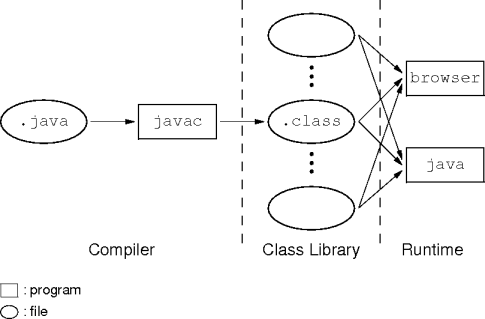
Java Components
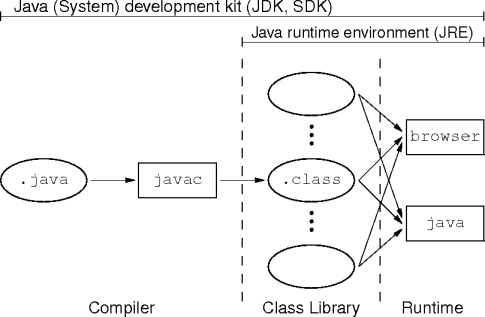
Java Versions
- Use the
-versionoption to find the installed version.$ java -version java version "1.6.0_03" Java(TM) SE Runtime Environment (build 1.6.0_03-b05) Java HotSpot(TM) Client VM (build 1.6.0_03-b05, mixed mode) $ javac -version javac 1.6.0_03 $
- Relevant versions are:
1.1- Obsolete; stubborn web developers.
1.5 (J2SE 5) - Earliest version (Core Java 7th ed).
1.6 (J2SE 6) - Course version (Core Java 8th ed).
Java Environments
- Java has four main environments:
- The server (J2EE); Enterprise edition.
- The desktop (J2SE); Standard edition.
- The browser; Plug-in part of J2SE.
- Portables (J2ME); Micro edition.
- This course uses the standard edition (J2SE 5 or 6).
Documentation
- The Java system has extensive documentation.
- From Sun via the web
or
by download.
- Install a local copy for fast access.
- Alternate searches and printing too.
- You can also buy documentation (a.k.a. books).
- They go out of date distressingly fast.
- Become adept with some form of documentation.
Documentation Types
- The two main documentation sets are for
the class library APIs and
the JDK.
- Other documentation includes sample programs, tutorials, and white papers.
- The
javadoctool helps document class libraries in the Java style.- Any class library you use or create should be documented.
IDEs
- An integrated development environment (IDE) is a hopped-up editor.
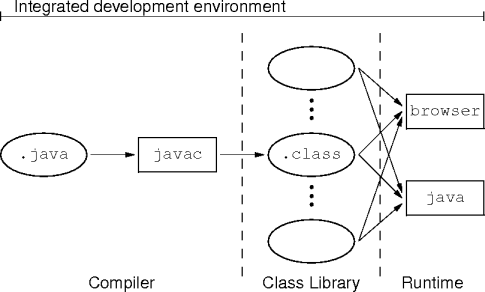
Java IDEs
- There’s a fair number of Java IDEs.
Eclipse
NetBeans
BlueJ
DrJava
Emacs + macros (JDEE, for example) - There are others, including those you pay for.
DrJava
- DrJava is a simple IDE for Java.
- BlueJ < DrJava < Eclipse.
- Available in the class directory
/export/home/class/cs-310/drjava
- Run it with
$ java -jar /export/home/class/cs-310/drjava/drjava-*.jar
Example.
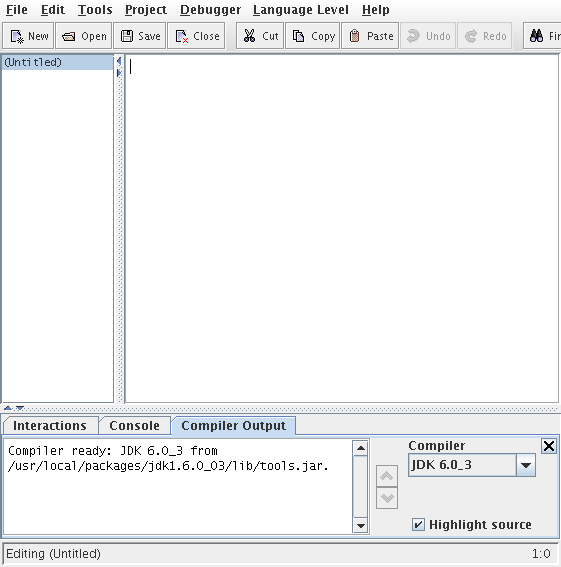
Example..
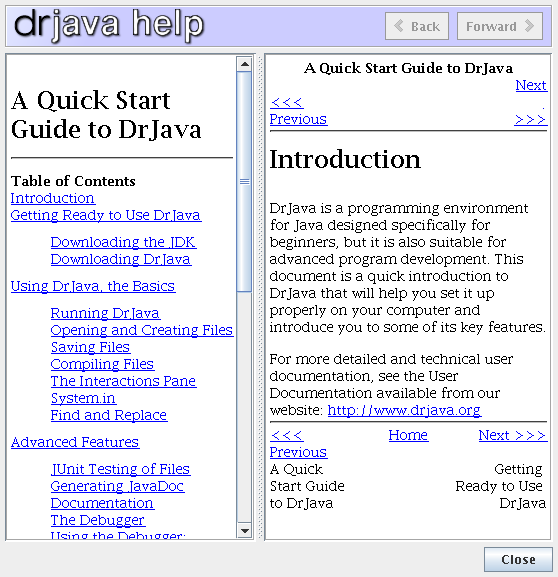
Example...
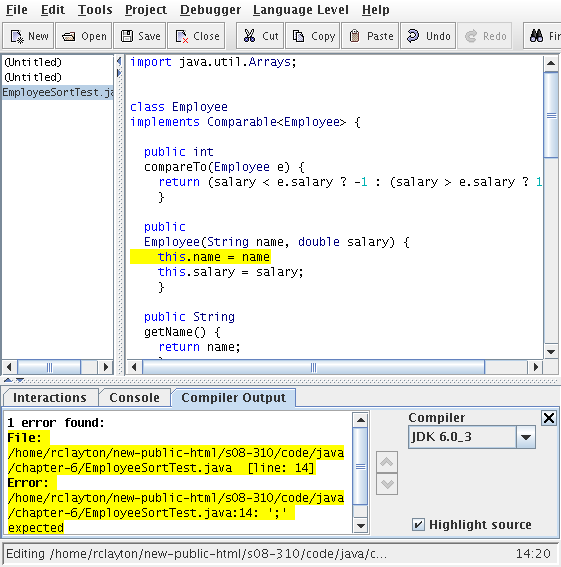
Example....
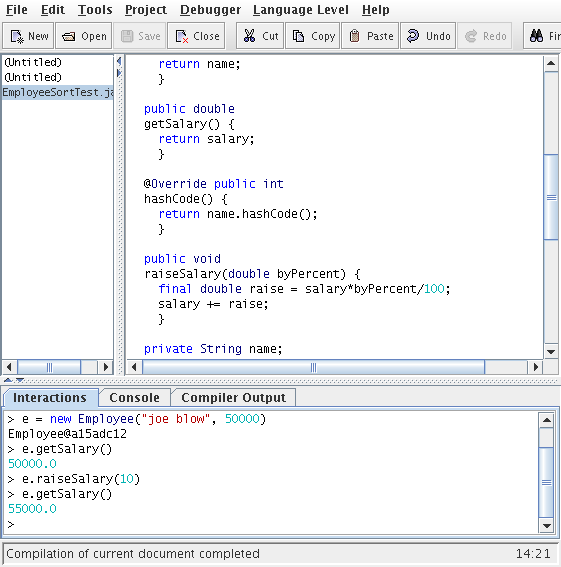
Analysis and Testing
- Java analyzes and tests well.
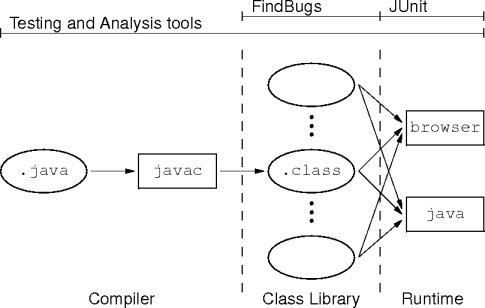
FindBugs
- FindBugs is a static analyzer for errors and infelicities in Java code.
- “Static” means the analyzed code isn’t executed.
- Your assignments will be run through FindBugs.
- Available in the class directory
/export/home/class/cs-310/findbugs-1.2.1
Example.
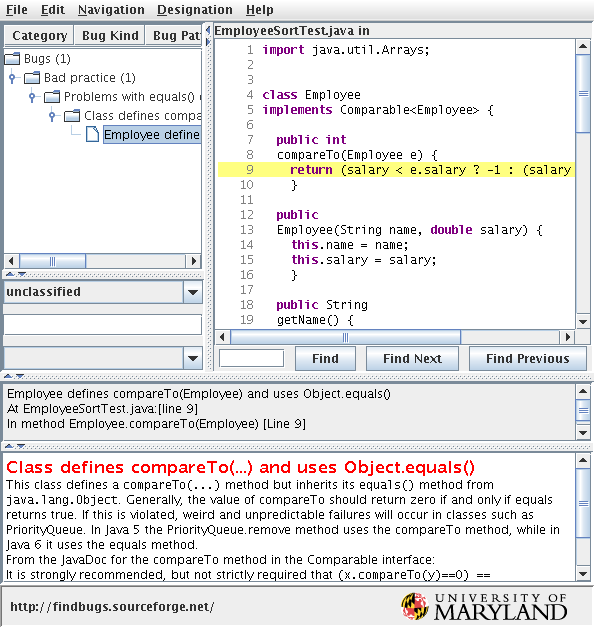
Example..
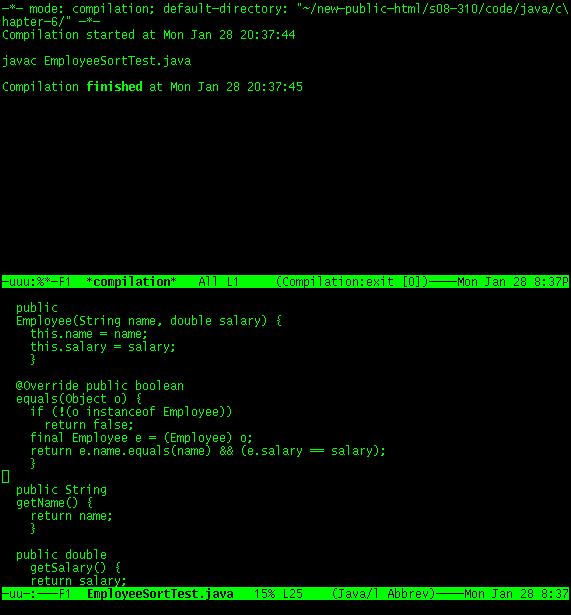
Example...
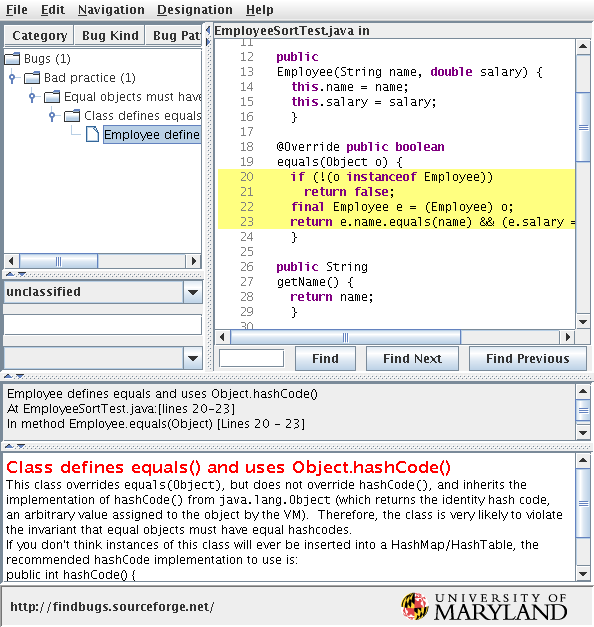
Example....
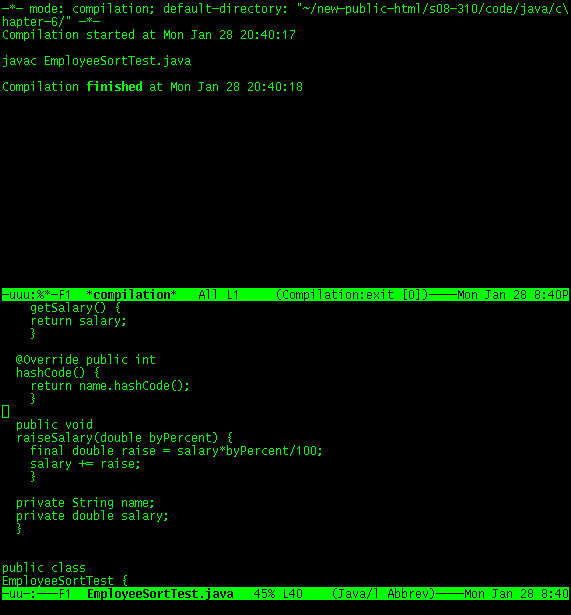
Example.....
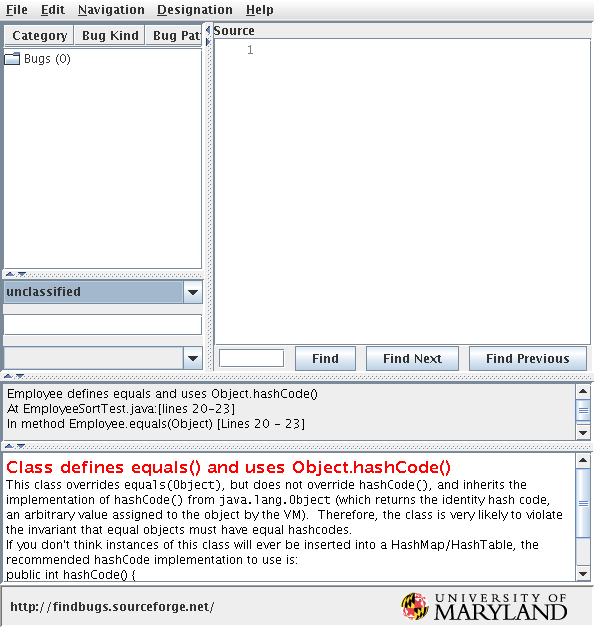
Example......
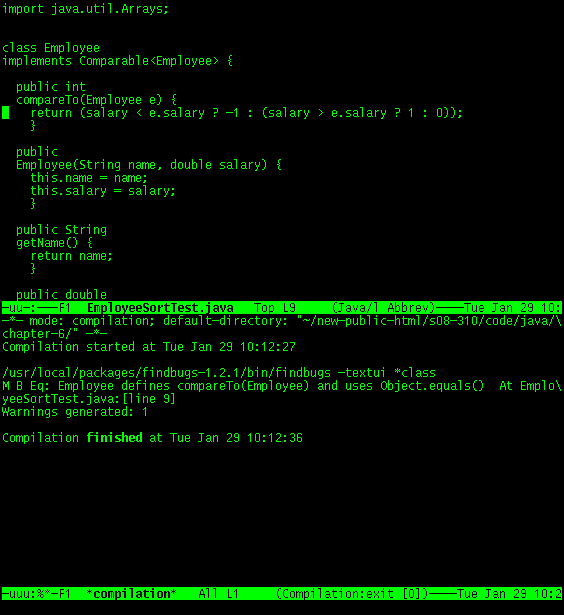
FindBugs on the Cheap
- The Java compiler’s
-Xlintcommand-line option performs checks similar to FindBug’s checks.- Similar to but not as detailed or as thorough.
- On the other hand, what’s it cost you?
Oh, One Last Thing
$ ls
AnonymousInnerClassTest.java ForEachTest.java StaticInnerClassTest.java
CloneTest.java InnerClassTest2.java TimerTest.java
EmployeeSortTest.java InnerClassTest.java
$ findbugs -textui *.class
Exception in thread "main" java.io.IOException: IOException while scanning codebases
at findbugs.FindBugs2.execute(FindBugs2.java:187)
at findbugs.FindBugs.runMain(FindBugs.java:1521)
at findbugs.FindBugs2.main(FindBugs2.java:731)
Caused by: findbugs.classfile.ResourceNotFoundException: Resource not found:
/home/rclayton/new-public-html/s08-310/code/java/chapter-6/*.class
at findbugs.classfile.impl.SingleFileCodeBase.getClassDescriptor(SingleFileCodeBase.java:222)
at findbugs.classfile.impl.SingleFileCodeBaseEntry.getClassDescriptor(SingleFileCodeBaseEntry.java:61)
at findbugs.classfile.impl.ClassPathBuilder.build(ClassPathBuilder.java:229)
at findbugs.FindBugs2.buildClassPath(FindBugs2.java:432)
at findbugs.FindBugs2.execute(FindBugs2.java:160)
... 2 more
$ for i in *.java ; do javac $i ; done
$ findbugs -textui *.class
M B Eq: Employee defines compareTo(Employee) and uses Object.equals() At EmployeeSortTest.java:[line 9]
Warnings generated: 1
$
- The cobbler’s children have no shoes.
But Rather
$ ls AnonymousInnerClassTest.java InnerClassTest2.java CloneTest.java InnerClassTest.java EmployeeSortTest.java StaticInnerClassTest.java ForEachTest.java TimerTest.java $ findbugs -textui *.class Can't find *.class. $ for i in *.java ; do javac $i ; done $ findbugs -textui *.class M B Eq: Employee defines compareTo(Employee) and uses Object.equals() At EmployeeSortTest.java:[line 9] Warnings generated: 1 $
JUnit
- JUnit is a unit-testing framework for Java.
- Unit tests are tests on small portions of a system.
- In Java the unit’s usually a class.
- Available in the class directory
/export/home/class/cs-310/junit4.1
- When possible, assignments will have JUnit tests.
Example.
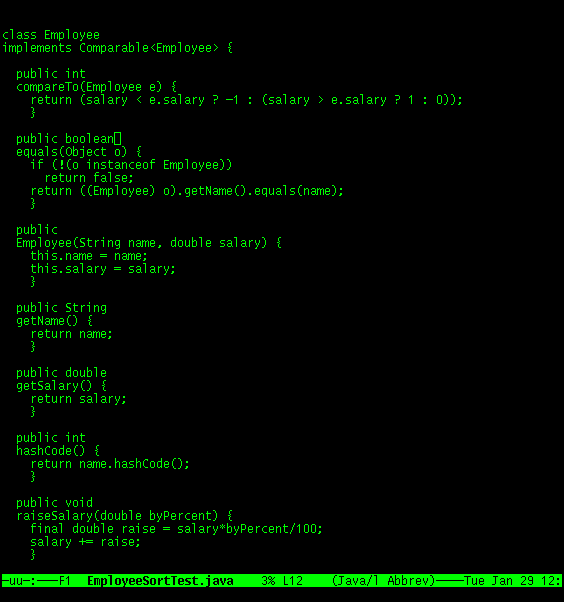
Example..
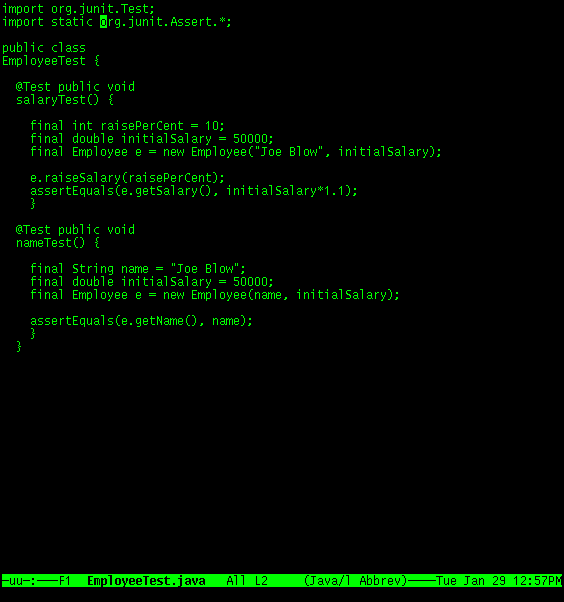
Example...
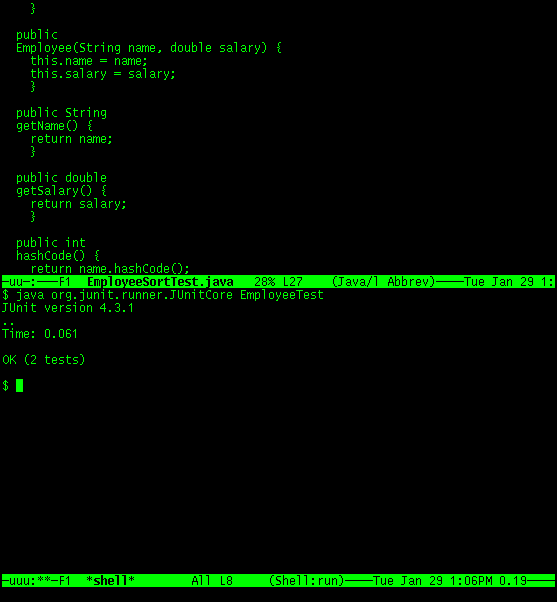
Example....
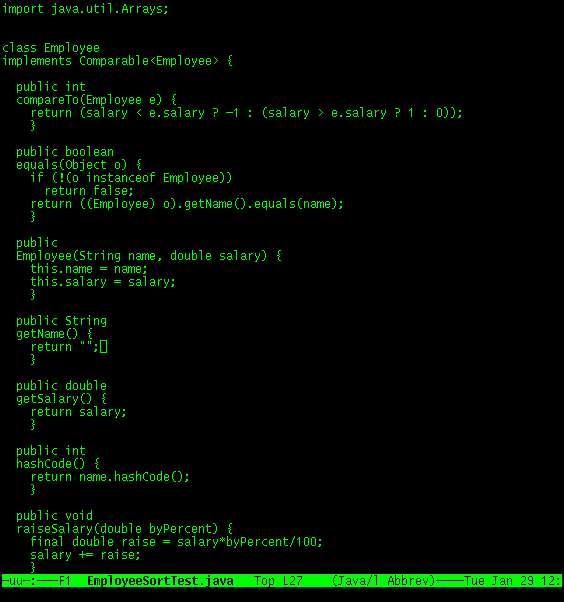
Example.....
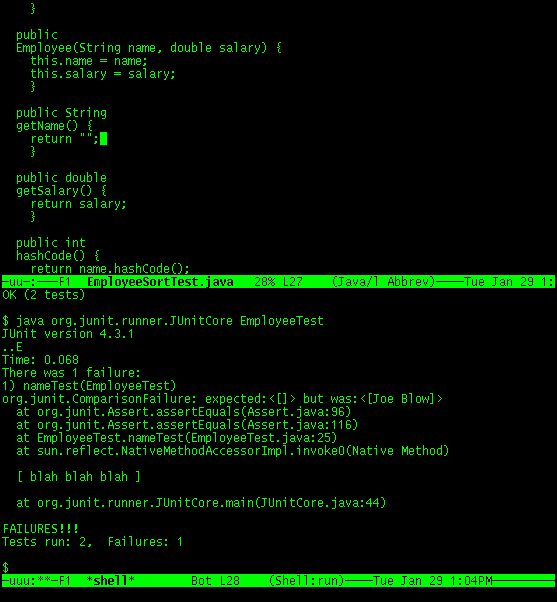
Testing Tips
- Do it.
- Write lots of small, simple tests and run them all the time.
- Replicate every error as a test.
- Learn thyself.
- Make sure your fixes stay fixed.
- Develop code in measured steps and keep the tests up-to-date (and passing).
Non-Sun Java
- Sun encourages independent implementations of Java parts.
- Specs and reference implementations are freely available.
- Names are still protected and licensed.
- Alternative implementations may have more appropriate properties.
- It won’t make much difference for this course.
Non-Sun JVMs
- There’s a fair number of JVM implementations.
- Particularly true with non-PC-like hardware.
- Motivated by research, curiosity, or licensing.
- Examples
- Jikes, originally from IBM, now open source.
- Kaffe, a clean-room implementation of the JVM and class libraries.
Non-Sun Libraries
- Gnu Classpath is an almost
complete reimplementation of the class libraries.
- Other reimplementations include GNU Classpath.
- Third parties provide libraries to extend the standard class libraries.
- The SWT from the Eclipse project.
Non-Sun Java Compilers
- The main non-Sun compiler is the GNU
compiler for Java (GCJ).
- Compiles Java to bytecode or native code.
- Fast compile and execution.
- Perhaps familiar debugging with gdb.
- Many bytecode-to-native compilers.
- Many compilation- and execution-oriented tools.
Scripting Languages
- A scripting language is a language designed to be implemented
by an interpreter.
- This is different from a language that can be interpreted (or, maybe, it’s not).
- The absence of a edit-compile-link-execute cycle is the mark of an
interpreted language.
- Instead it’s edit-execute.
- Relaxed syntax and pragmatic semantics is another.
JVM-Based Languages
- Hey! The JVM’s a (bytecode) interpreter.
- Translate a language to bytecode and run it (interpret it) on the JVM.
- JVM bytecode is high-level for straightforward (maybe) translation.
- The JVM environment is portable and feature-full for free.
- Free and immediate access to available class libraries.
JVM-Based Languages
- There are many JVM-based scripting languages; some familiar
- JPython, Jacl (TCL/TK), JScheme, JRuby, …
and some less so
- Groovy, BeanShell, Pnuts, …
- Choice is a matter of features and taste.
BeanShell
- The BeanShell is an example of a scripting language.
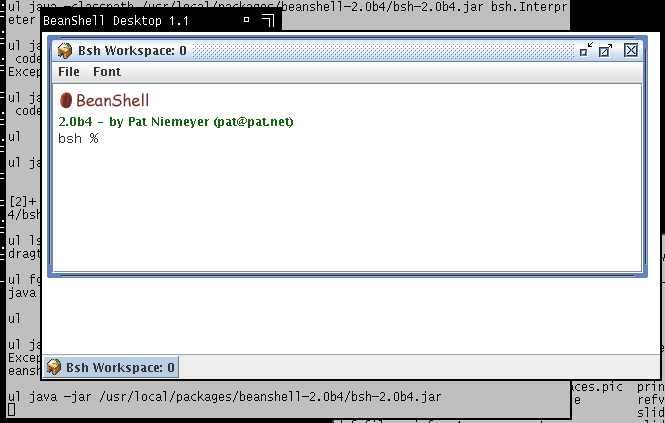
On-Demand Variables
- Variables can be introduced as needed.
- The scripting environment keeps track of them as used.
- Variables are also dynamically typed; no declarations needed.
- Type declarations can be used to improve script robustness (and perhaps efficiency).
Variables Example
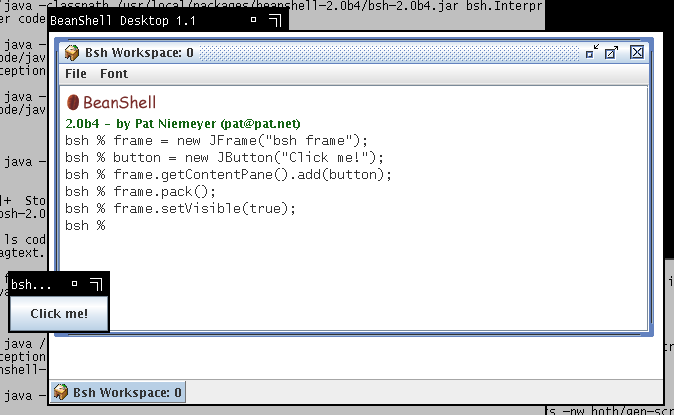
Dynamic Environment
- A scripting environment can be updated dynamically and iteratively.
- This is the basis of a scripting language’s exploratory nature.
BeanShell Example
- Create and add an action listener to the button.
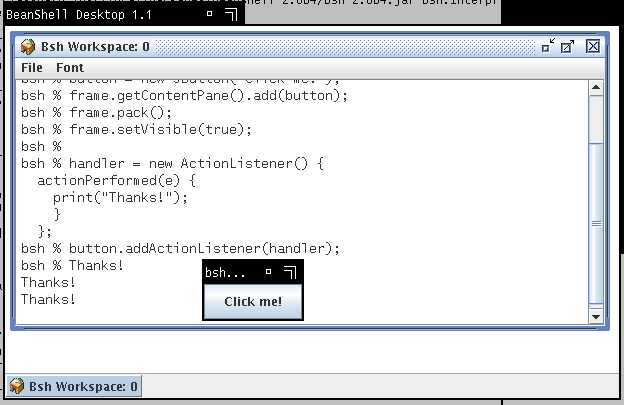
Extended Syntax
- The scripting language doesn’t have to be faithful to Java language
syntax.
- Just as long as there’s a consistent interpretation to the variant syntax.
- A scripting language can implement variant syntax to simplify Java
features.
- Really friendly scripting languages let you define your own syntax.
Extended-Syntax Example
$ java -classpath bsh-2.0b4.jar bsh.Interpreter
BeanShell 2.0b4 - by Pat Niemeyer (pat@pat.net)
bsh % map = new java.util.Hashtable();
bsh % print(map.get("one"));
null
bsh % map.put("one", 1);
bsh % print(map.get("one"));
1
bsh % print(map{"two"});
null
bsh % map{"two"} = 2;
bsh % print(map{"two"});
2
bsh % button = new JButton();
bsh % print(button.getLabel());
bsh % button.setLabel("Click me!");
bsh % print(button{"label"});
Click me!
bsh % button.label = "Press to play";
bsh % print(button.label);
Press to play
bsh %
Interactive Run-Time
- Interactive environments can demand less up-front information.
- This another way scripting languages can be more terse than Java.
- And can also spend the time to recover (or discover) information.
- Scripting languages are mostly dynamic, while Java is mostly static.
Run-Time Discovery Example
$ java -classpath bsh-2.0b4.jar bsh.Interpreter
BeanShell 2.0b4 - by Pat Niemeyer (pat@pat.net)
bsh %
bsh % add(a, b) { return a + b; }
bsh %
bsh % print(add(1, 2));
3
bsh % print(add("hello ", "world!"));
hello world!
bsh %
bsh % print(add("hello ", 1));
hello 1
bsh %
Static-Typing Example
bsh %
bsh % int add(int a, int b) { return a + b; }
bsh %
bsh % bsh % print(add(1, 2));
3
bsh % print(add("1", "2"));
// Error: EvalError: Command not found:
add( java.lang.String, java.lang.String ) :
at Line: 3 : in file: <unknown file> :
add ( "1" , "2" )
bsh %
The Environment as this
- The definitions given the environment can be used to implement interfaces or extend classes.
- The environment is treated as a giant class instance.
- For some anonymous class.
- The environment’s available as
this.
This-Environment Example
$ java -classpath bsh-2.0b4.jar bsh.Interpreter
BeanShell 2.0b4 - by Pat Niemeyer (pat@pat.net)
bsh % button = new JButton("Click me!");
bsh % frame = new JFrame();
bsh % frame.getContentPane().add(button);
bsh % frame.pack();
bsh % frame.setVisible(true);
bsh %
bsh % actionPerformed(e) { print("Thanks!"); }
bsh %
bsh % button.addActionListener(this);
bsh % Thanks!
Thanks!
Thanks!
bsh %
BeanShell Example.
dragText() {
f = new Frame("Drag in the box");
f.setFont(new Font("Serif", Font.BOLD, 24));
f.setSize(300, 300);
f.show();
gc = f.getGraphics();
gc.setColor(Color.cyan);
mouseDragged(e) {
gc.drawString("Drag Me!", e.getX(), e.getY());
}
mouseMoved(e) { }
f.addMouseMotionListener(this);
}
BeanShell Example..
dragText() {
f = new Frame("Drag in the box");
f.setFont(new Font("Serif", Font.BOLD, 24));
f.setSize(300, 300);
f.show();
gc = f.getGraphics();
gc.setColor(Color.cyan);
mouseDragged(e) {
gc.drawString("Drag Me!", e.getX(), e.getY());
}
mouseMoved(e) { }
f.addMouseMotionListener(this);
}
Java Debuggers
- Assertions and testing should reduce the need for debuggers.
- They find problems found early and exactly.
- Debuggers are usually integrated with an IDE.
- Either stand-alone or IDE-custom debuggers.
Java Debugging
- The JVM defines the
Java
Platform Debugger Architecture (JPDA).
- A set of related top-, middle-, and botom-level protocols.
- JDB is an simple text-based debugger.
- It mostly illustrates how the JPDA is used.
Summary
- Use the Java 5 or 6 Standard Environment (J2SE 5 or 6).
- Java is a relatively easy language to write tools for.
- Avail yourself of them.
- Maybe write a tool yourself.
- Learn how to use FindBugs and JUnit (and then use them).
References
- Using Static Analysis For Software Defect Detection by Bill Pugh, Google TechTalks, 2007 July 23.
Credits
- Stone Carving Tools At The Library Of Congress: Gear, Circular Saw Blade, Rasp, Hammers, Rifflers, Pointing Machine (Washington, DC) by takomabibelot, under an AT Creative-Commons license.
